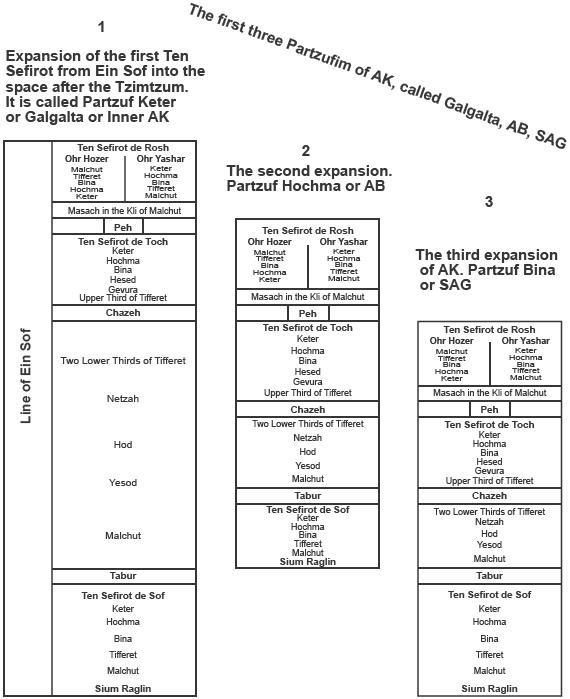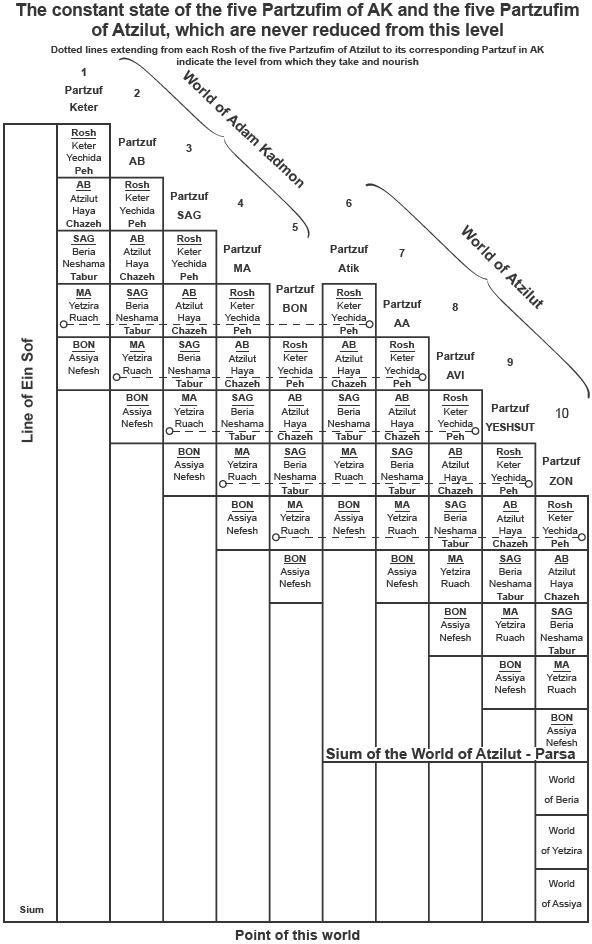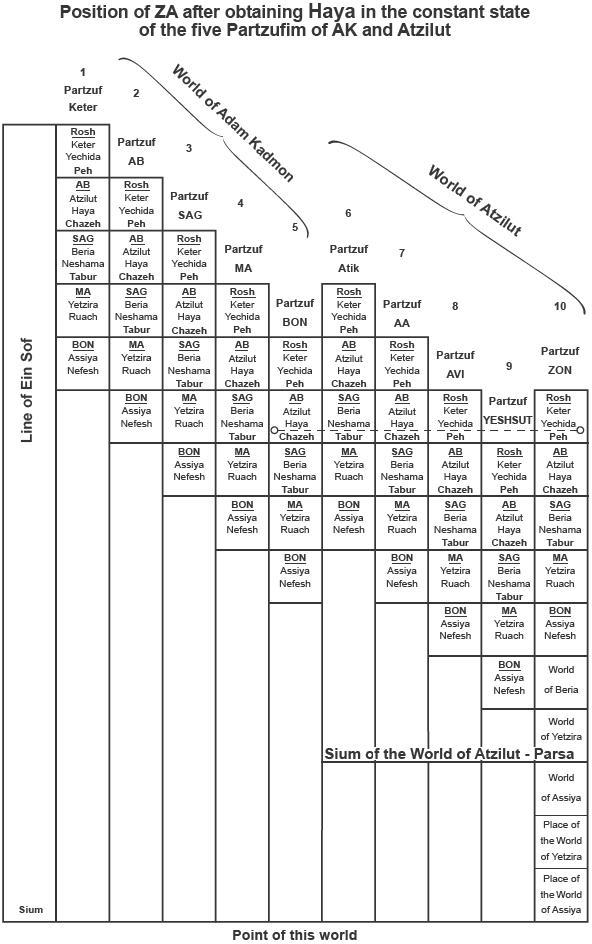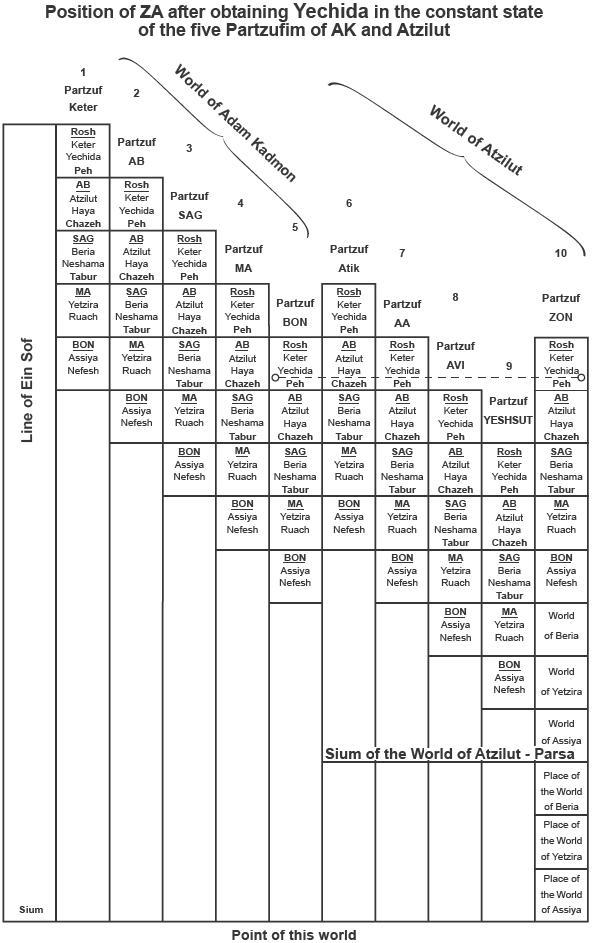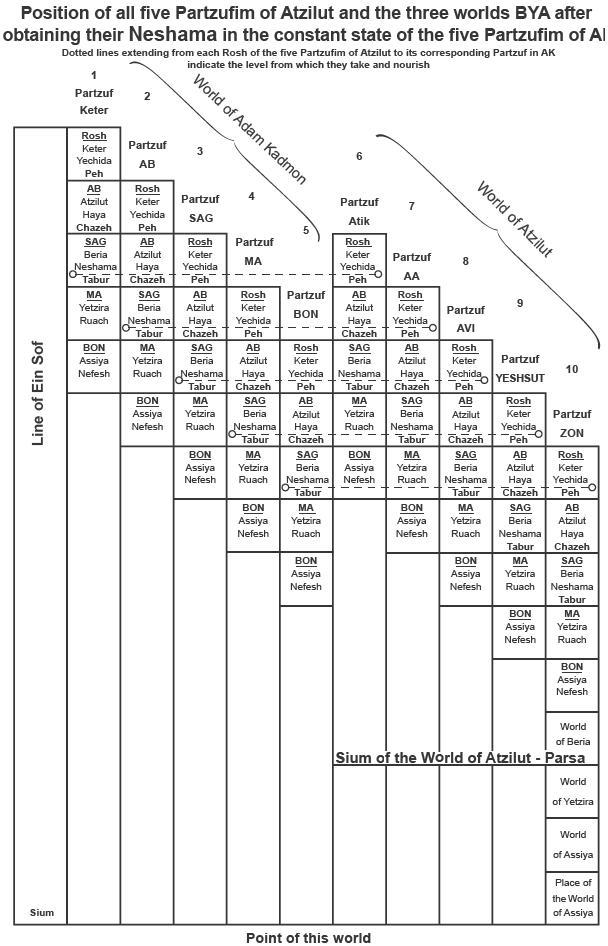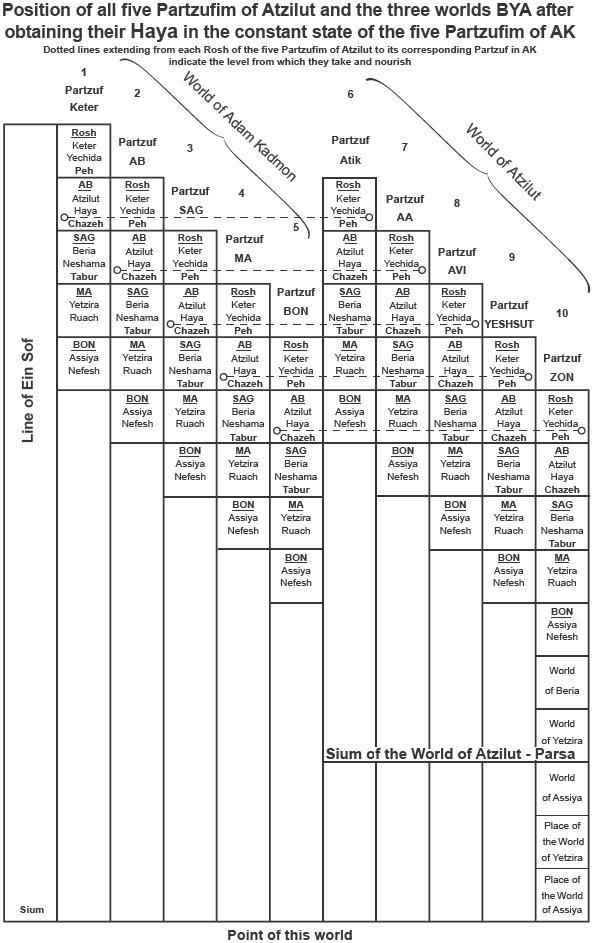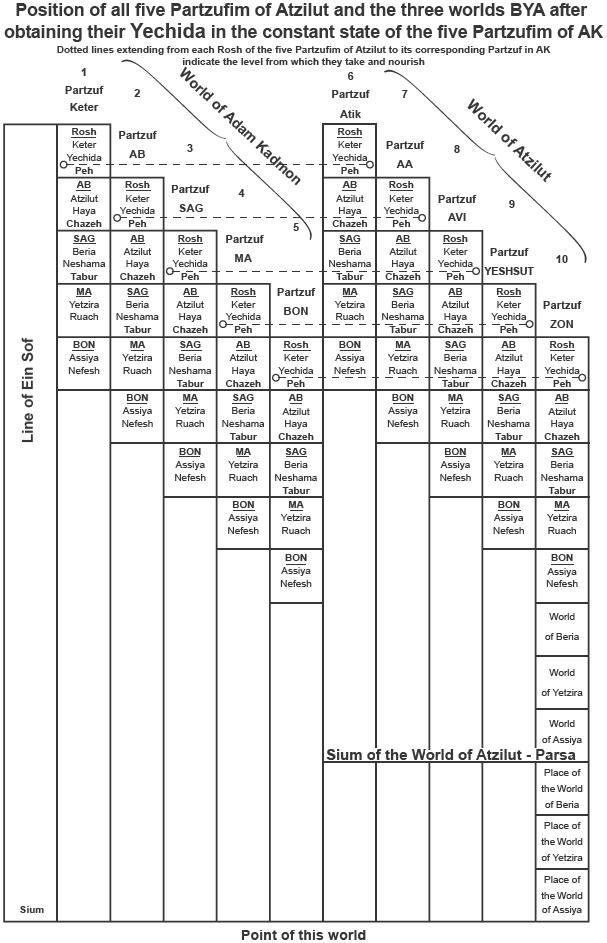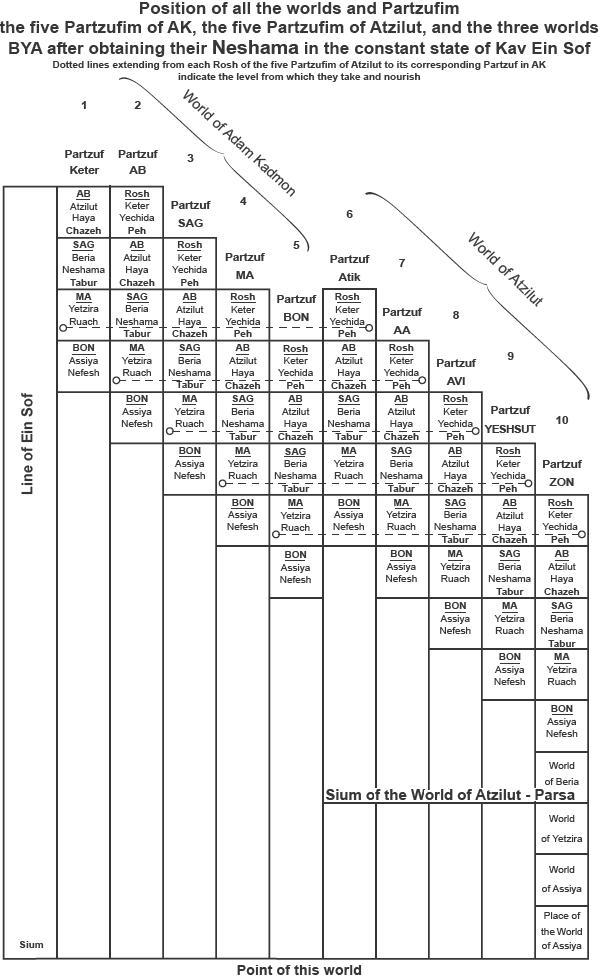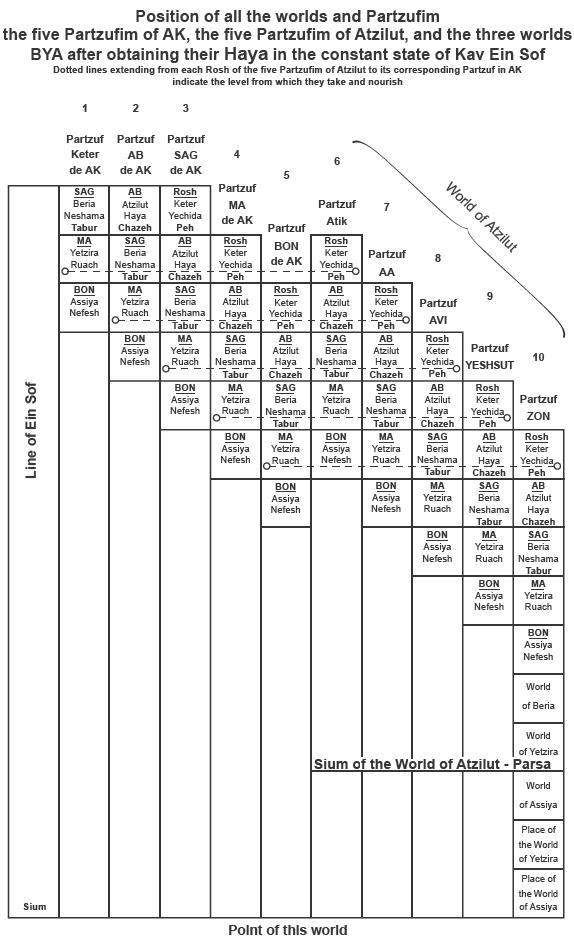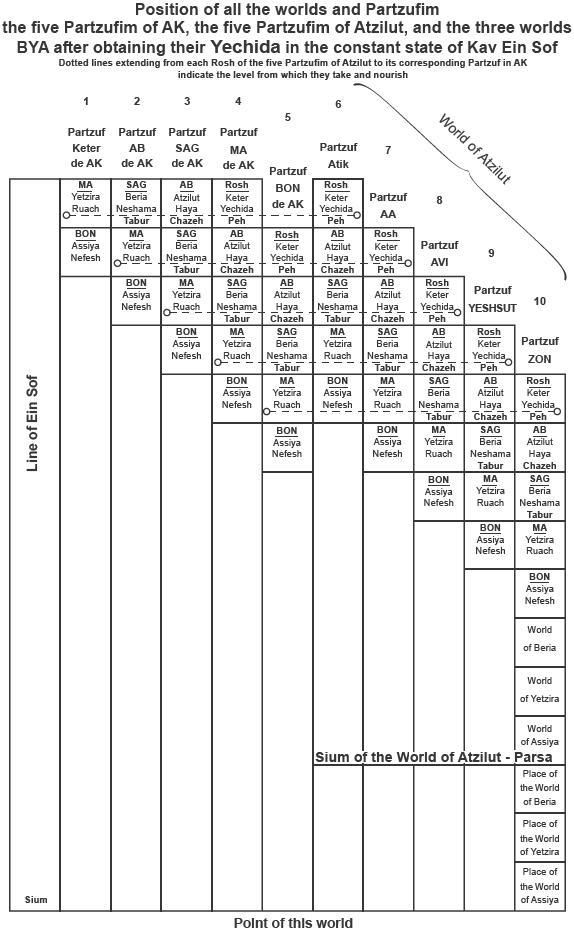Ha-Ilan (The Tree)
Diagram 1
-
Item 1 depicts the Rosh, Toch, Sof of Partzuf Keter de AK.
-
Item 2 depicts Partzuf AB de AK in Rosh, Toch, Sof and how it clothes Partzuf Keter de AK from its Peh down.
-
Item 3 depicts Partzuf SAG de AK in Rosh, Toch, Sof and how it clothes Partzuf AB de AK from its Peh down.
Diagram 1, Item 1
This is Partzuf Keter de AK, the first ten Sefirot that expanded from Ein Sof into the space after the Tzimtzum. Its Rosh touches Ein Sof, Above, and its Sium Raglin is in the middle, central point, which is this world. It contains three Behinot of ten Sefirot: ten Sefirot de (of) Rosh, ten Sefirot de Toch, and ten Sefirot de Sof.
The ten Sefirot de Rosh are called “the roots of the ten Sefirot,” since there is the beginning of their creation, through the meeting of the ten Sefirot de Ohr Yashar by the Zivug de Hakaa in the Masach in Malchut de Rosh, which raises ten Sefirot de Ohr Hozer that clothe the ten Sefirot de Ohr Yashar, which extend from Ein Sof (as it is written in The Tree of Life, Gate 47, Chapter 1). The ten Sefirot de Ohr Yashar are arranged from Above downwards, and their opposite is the Ohr Hozer, where they are arranged from below Upwards. Malchut of the ten Sefirot de Rosh is called Peh.
The ten Sefirot de Toch in the Partzufim of AK is called Akudim, in Partzuf Keter, in AB, as well as in SAG. Yet, in Partzuf Keter, the Upper Light was not yet distinguished in ten Sefirot, and the difference between them was only in impressions (as the Ari wrote in The Tree of Life, Section Present and Not Present, Chapter 1). Also, Malchut of the ten Sefirot de Toch is called Tabur.
The ten Sefirot de Sof are considered the Sium of each Sefira of the ten Sefirot through Malchut. The Partzuf ends in the Sefira of Malchut, which is why she is called Sium Raglin.
Diagram 1, Item 2
This is Partzuf AB de AK, the second Hitpashtut of ten Sefirot from Ein Sof into the space, after the Tzimtzum. It begins from Hochma, and lacks the Light of Keter. It is emanated and comes out of Malchut de Rosh of Partzuf Keter, which is called Peh. Hence, it clothes Partzuf Keter from its Peh down to Tabur of Partzuf Keter.
Its ten Sefirot de Rosh are like the ten Sefirot de Rosh of Partzuf Keter de AK, except that it lacks Keter. The elicitation of these ten Sefirot is elaborated on in The Tree of Life, Section Present and Not Present, Chapters 1 and 2, as well as in Talmud Eser Sefirot, Part 5, where these words of the Ari are thoroughly explained.
Here, the ten Sefirot de Toch become more conspicuous than the ten Sefirot de Toch in Partzuf Keter, since here there were ten entrances and ten exits in the order of Present and Not Present (as it is written in The Tree of Life, Section Present and Not Present, and in Talmud Eser Sefirot, Part 5). In the Sefira Keter of the ten Sefirot de Toch, there are two Kelim, called Yod- Hey. This is so in their Sefira Hochma, too, but in the Sefira Bina, the Yod- Hey are only in one Kli, and the Vav is in the Kli of Yesod, and the bottom Hey is in Malchut.
The ten Sefirot de Sof are the same as in Partzuf Keter de AK, except its Sium Raglin is above the Tabur of Partzuf Keter.
Diagram 1, Item 3
This is Partzuf SAG de AK, the third expansion of ten Sefirot from Ein Sof into the space after the Tzimtzum, in Rosh, Toch, Sof. It is emanated and comes out of the Peh of Partzuf AB de AK. It begins from Bina and lacks the Lights Keter and Hochma, and clothes from the Peh of Partzuf AB de AK downwards, although below it is longer than it, since it expanded downwards, to the same level as the Sium Raglin of Partzuf Keter de AK.
Diagram 2, Item 1
This is the state of Partzuf SAG de AK during Tzimtzum Aleph. It is presented above, in Diagram 1, Item 3, but here there is the additional distinction of its own two Partzufim: Partzuf Taamim, from Peh to Tabur, and Partzuf Nekudim, from Tabur down. You will find their explanation in Talmud Eser Sefirot, Part 6, p 390.
Thus far, the three lower worlds Beria, Yetzira, and Assiya did not come to any existence, since SAG de AK, too, extended through the point of this world. It follows that it was considered Atzilut down to the point of this world.
Diagram 2, Item 2
This is the state of SAG de AK during Tzimtzum Bet, prior to the Zivug in Nikvey Eynaim, which was done in order to emanate the ten Sefirot de Nekudim. Because of the descent of SAG into the inner MA and BON de AK, Bina received the Behinat Malchut. Thus, the ending Malchut, which stood at the point of this world, rose to the place of Tabur, and the mating Malchut, which stood at Peh de Rosh de SAG, rose to the place of Nikvey Eynaim de Rosh de SAG, and the Awzen, Hotem, Peh de Rosh descended to Behinat Guf de SAG. Also, the Light was emptied from Tabur down, and this, in general, is Partzuf SAG.
And there is Rosh, Toch, Sof, called HBD, HGT, NHYM in its own Partzuf Nekudot de SAG, standing entirely below the Tabur (see above, diagram 2, Item 1). In it, too, as in general, it is considered that the ending Malchut rose to Bina de Guf, called Tifferet, in the place of its Chazeh, where the line of Ein Sof ended, and below it the Parsa was established, since this is where Behinat Atzilut ended.
From there down, it became the place of the three worlds Beria, Yetzira, and Assiya. The world of Beria was made of the two bottom thirds of Tifferet, down to its Sium. The world of Yetzira was made of Netzah, Hod, and Yesod, and the world of Assiya was made of Malchut. This is thoroughly explained in the words of the Ari, p 8, and in Ohr Pashut there.
Diagram 2, Item 3
This is the state in SAG de AK during the Zivug that was made in Nikvey Eynaim: the Awzen, Hotem, Peh came out of Behinat Rosh and into Guf, below the place of the Zivug de Rosh. Yet, since there is no absence in the spiritual, two kinds of Awzen, Hotem, and Peh are discerned here: the first are the Awzen, Hotem, Peh at their exit spot, their place at the Rosh, as in the beginning. The second are the Awzen, Hotem, Peh that descended into actual Behinat Guf below Peh de Rosh de SAG. They are called Awzen, Hotem, Peh not in the place of their exit. And all those are called “inner Awzen, Hotem, Peh.”
Here, the ten Sefirot de Toch through Tabur are called Akudim, as prior to Tzimtzum Bet, since the ten Sefirot that came out of the Zivug de Nikvey Eynaim could only manifest below Tabur. These are called “ten Sefirot de Nekudim,” and they came out primarily outside of Partzuf SAG, although their internality emerged in AK itself.
Also, they are called MA and BON de AK, since the internality of the Upper three of Nekudim is called MA de AK and the internality of the lower seven of Nekudim is called BON de AK. They end at the point of Sium of Tzimtzum Bet, called “the Parsa between Atzilut and Beria.” Below it are the three worlds, lower Beria, Yetzira, and Assiya.
Diagram 2, Item 4
This is an external Partzuf Awzen, Hotem, Peh de SAG de AK, through Tabur. From Tabur down, it is Partzuf of ten Sefirot de Nekudim, which end at the Parsa. Below Parsa stand the three worlds, lower Beria, Yetzira, and Assiya.
In the external ones, the Awzen, Hotem, Peh are divided into two Behinot Awzen, Hotem, Peh: external Awzen, Hotem, Peh, at the place of their elicitation, standing above the Peh, and external Awzen, Hotem, Peh, not in their elicitation place, standing from below the Peh through Tabur. Their Upper three are attached to the bottom lip. It is called Shibolet ha Zakan (the bit of hair under the bottom lip), and the Upper three are primarily the Light of Awzen, but their Behinot Hotem, Peh are included in them, too. These are the roots of the Upper three of Nekudim.
Their lower seven, which are the actual Hotem and Peh, stand below Shibolet ha Zakan and spread through the Tabur. These external Awzen, Hotem, Peh are also called Dikna (beard) de SAG de AK, and you will find a detailed explanation of them in Talmud Eser Sefirot, Part 6, p 409, Item 20.
The ten Sefirot de Nekudim stand from Tabur downwards. Their First three are in Tikkun Kavim and clothe MA de AK, and their bottom seven are one below the other, as in Tzimtzum Aleph, clothing BON de AK. Below them are the Parsa and the three worlds Beria, Yetzira, and Assiya, under the Parsa.
Diagram 3, Item 1
This is the constant state of the five Partzufim of AK, from which the five Partzufim of the new MA emerged, called “the five constant Partzufim of Atzilut.” Once they were established, no diminution will ever occur in them.
It also explains the division of each Partzuf into Keter, Atzilut, Beria, Yetzira, and Assiya, which are also called Keter, AB, SAG, MA, and BON, or Yechida, Haya, Neshama, Ruach, and Nefesh. Each Rosh, through the Peh, is called Keter or Yechida. From Peh through Chazeh in each of them, it is called Atzilut or AB or Haya. And from Chazeh to Tabur in each of them, it is called Beria or Neshama or SAG. And from Tabur down to each of them, it is called Yetzira and Assiya, or MA and BON, or Ruach- Nefesh.
Additionally, it explains their clothing within one another. Each clothes its Superior from the Peh of its Superior downwards in such a way that the Rosh of each lower one clothes the AB and Atzilut of the Upper One, and AB and Atzilut of the lower one clothe the SAG and Beria of its Superior.
Also, SAG and Beria of each lower one clothe MA and BON, which is Yetzira and Assiya of the Upper One. Thus, the Peh of the Upper One is considered the Galgalta of the lower one, and the Chazeh of the Upper One is considered Peh of the lower one, and Tabur of the Upper One is considered the Chazeh of the lower one.
Also, it explains the elicitation of the new MA in each of the five Partzufim of Atzilut, the MA in its corresponding Partzuf in AK.
Diagram 4
The state of ZA during its ascension to obtain Neshama, with respect to the constant five Partzufim of AK and Atzilut, and how it takes and nourishes off Beria de BON de AK—its corresponding Partzuf in AK.
Diagram 5
The state of ZA during its ascension to obtain Haya, with respect to the constant five Partzufim of AK and Atzilut, and how it takes and nourishes off Atzilut de BON de AK—its corresponding Partzuf in AK.
Diagram 6
The state of ZA during its ascension to obtain Yechida, with respect to the constant five Partzufim of AK and Atzilut, and how it takes and nourishes off Rosh de BON de AK—its corresponding Partzuf in AK.
Diagram 7
The states of the five Partzufim of Atzilut upon their ascent to obtain Neshama, with respect to the five constant Partzufim of AK, and how each takes and nourishes off its corresponding Partzuf in AK.
Diagram 8
The states of the five Partzufim of Atzilut upon their ascent to obtain Haya, with respect to the five constant Partzufim of AK, and how each takes and nourishes off its corresponding Partzuf in AK.
Diagram 9
The states of the five Partzufim of Atzilut upon their ascent to obtain Yechida, with respect to the five constant Partzufim of AK, and how each takes and nourishes off its corresponding Partzuf in AK.
Diagrams 10, 11, 12
These depict how the ladder of degrees never changes, and the degrees, as a whole, always remain as they were in their beginning, at the time of the elicitation of the new MA, as in the constant state. This is so because when ZA ascends and obtains Neshama, all the degrees rise along with it—the five Partzufim of AK and Atzilut—and each obtains the Behinat Neshama related to it. It is similar in obtaining Haya de ZA and obtaining Yechida de ZA.
Diagram 10 is the state of the five Partzufim of AK as they ascend to obtain Neshama. Diagram 11 depicts their state when they obtain Haya, and Diagram 12 is their state when they obtain Yechida.
Diagram no. 1
Diagram no. 2
Diagram no. 3
Diagram no. 4
Diagram no. 5
Diagram no. 6
Diagram no. 7
Diagram no. 8
Diagram no. 9
Diagram no. 10
Diagram no. 11
Diagram no. 12
